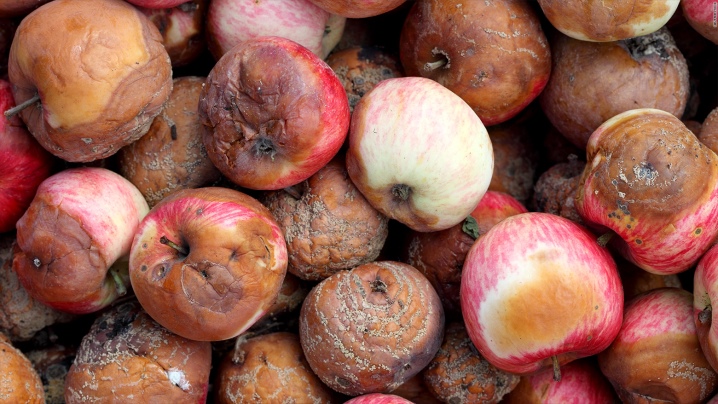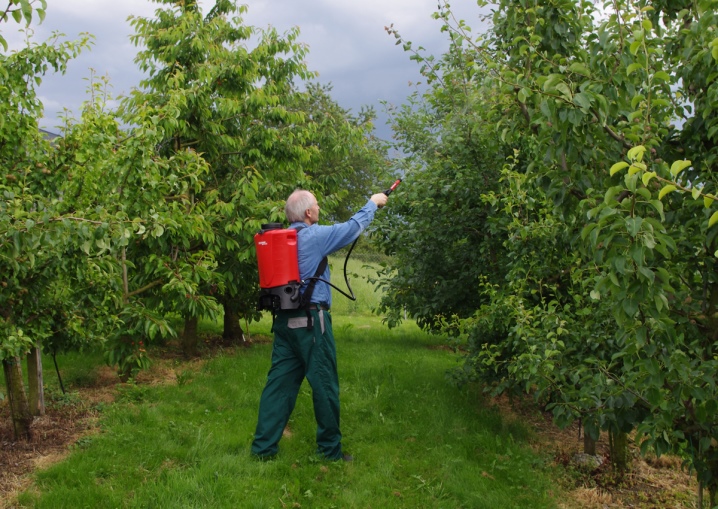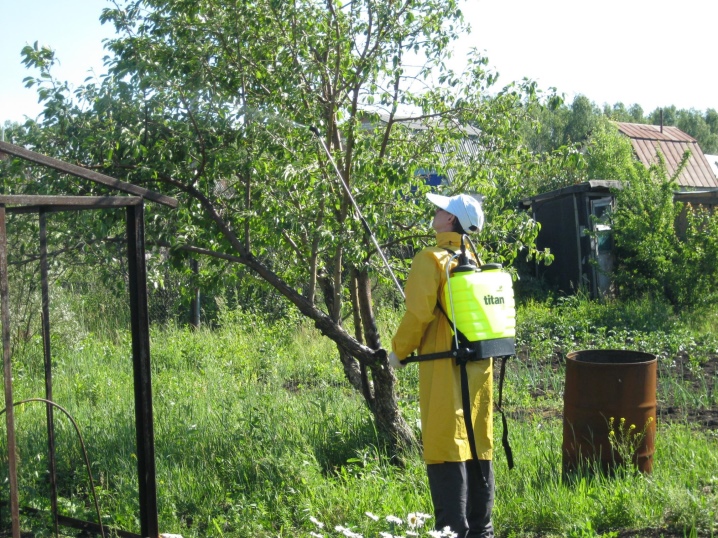All about fertilizing apple trees in spring

If more than 3-5 years have passed since the planting of the apple tree, and the soil on the site is poor, spring top dressing is required. The nutrients introduced during planting are no longer enough. How and how to feed - you need to know everything about fertilizing apple trees in spring, if you want to get bountiful harvests even on a site with overworked soil.

What can you contribute?
All fertilizers are divided into two groups.
- Organic: manure, chicken droppings, peat, ash, bone meal, silt, compost.
- Mineral: potash, nitrogen (the most famous is urea, or carbamide), phosphoric. This also includes complex mineral mixtures: ammonium nitrate, ammonium sulfate, industrial compositions "Factorial", "Ideal", "Fertility", specially designed to make the apple tree bear fruit better.
Organic ones are more environmentally friendly, contain a complex of useful substances, do not require excessively strict dosage, therefore they are more often used in personal subsidiary plots to increase the yield.


They are brought under the apple trees only in the fall. Mineral fertilizers are needed in spring and summer.
According to the method of feeding, there are root and foliar. The roots are brought into well-shed soil so as not to burn the roots. The crown is sprayed with nutrient solutions only in the evening, in the absence of the scorching rays of the sun.
In order for young trees to grow well, they are fed with phosphorus fertilizers. In the spring, make 2-3 potassium-phosphorus dressings. The rest is in August.
Nitrogen fertilizers will be required for 2-3 years of life. They are brought in completely in the spring.

The introduction of nitrogenous fertilizers under the apple tree in the second half of summer is not recommended - this worsens the winter hardiness of trees.
The norms of trace elements are given in the table
|
Apple tree age |
| Nitrogen, g / sq. m | Potassium, g / sq. m | Phosphorus, g / sq. m |
2-4th year
| 75 | 70 | 125 |
5-6th, 8th year
| 140 | 125 | 210 |
9-10th year and older
Carbamide, or urea. The most popular nitrogen fertilizer for large yields. Contains up to 46.2% nitrogen. Plus fertilizer - it dissolves well in water, but does not wash out into the lower layers of the soil for a long time. Acts softer than ammonium nitrate.


Consider the options for nitrogen-containing root dressing.
- "Ammonium sulfate". Contains 21-22% nitrogen, 24% sulfur, sodium - 8%. Pros: complex composition, suitable for stimulating growth, improves the taste of the crop.
- "Ammonium nitrate" - 26-34% nitrogen, 3-14% sulfur. Pros: it dissolves well, shows itself well on cold spring soils.
- Calcium nitrate. Contains 13-16% nitrogen and 19% calcium. Pros: neutralizes soil acidity, neutralizes excess iron or manganese.
Important! Excess nitrogen in the soil leads to a browning of the crop. Apples do not lie well, rot quickly. Excess potassium interferes with calcium absorption. The fruits turn glassy or become friable. Keeping quality is also greatly reduced.

Feeding stages
Spring feeding should be inscribed in the general scheme, before the fall. The plan could be like this:
- March 10 to April 15 - the first feeding with mineral fertilizers.
- End of June - application of fertilizers to the trunk circle.
- Aug. Sept - the first application of fertilizers to the soil.
- September October - root feeding with substances that improve resistance to cold weather.
It is necessary to ensure that the total amount of fertilizers for the season does not exceed the norm indicated in the table above.
It would be even more correct to analyze the composition of the soil in order to adjust the rate to your data.

You can determine the lack of specific elements by the following criteria:
- Low nitrogen: pale crushed leaves, rapid yellowing, small fruits at harvest.
- Lack of magnesium: light green spots on the leaves, necrosis at the edges, rapid foliage fall.
- Little phosphorus: unnaturally green foliage, poor harvest, chopped fruits.
- Lack of potassium: bluish foliage, which dries up in autumn, but does not fall off the branches. The fruits become smaller.
- Little iron: pale leaves, later drying out to brown crusts.
- Lack of zinc: small leaves collected in a rosette.
- Lack of copper: dark spots on the leaves, poor tree growth.
- Lack of calcium: glassy or friable fruits. Excessive intake of magnesium and potassium can lead to a lack of calcium.

Before bud break
Up to this point, the gardener can fertilize the apple trees by applying top dressing under the roots. There is no foliage yet, spraying for the sake of nutrition does not make sense. The options are:
- Immediately after winter, humus is introduced into the topsoil - 5 buckets per 1 tree. The method is best suited for young seedlings.
- Urea - 500-600 g per tree.
- Ammonium nitrate - 30-40 g per tree.
It is better to fertilize old trees with minerals rather than organic matter - their roots are already too deep. But digging the topsoil with fertile soil will also not be superfluous.
For your information. Spraying before bud break can be carried out with a solution of copper sulfate 0.05-0.10%, or with a solution of ferrous sulfate at the rate of 5 g of powder per 10 liters of water.
This will protect the apple tree from fungal and infectious diseases.

When leaves appear
From 10 to 15 April, when the leaves have already appeared, you can spray with micronutrient fertilizers. Solution options:
- Magnesium sulfate - 1% solution (with a lack of magnesium).
- Zinc sulfate - 300 g per 10 liters of water.
- Manganese sulfate - 0.1-0.5%.
- "Kemira Lux" - 20 g per 10 liters.
You can also spray with urea - dissolve 50 g of urea in 10 liters of water. Repeat every 10 days.
It is convenient to combine this method of urea application with the treatment of trees from pests.

Before using any solution, it is better to test it on 1 branch. If after a day something has changed, you need to prepare a weaker solution. Spray carefully, trying to process all branches and both sides of the leaves. In dry weather, use a weaker solution than in wet weather. But it is better to spray with fertilizers in wet weather - they are better absorbed. If it rains within 6 hours after spraying, it must be repeated.
If last year yellow leaves with red veins were found on apple trees, the trees became more sensitive to frost, and the harvest was "decorated" with rough, cork-like areas - the plants do not have enough boron. In this case, a special foliar dressing is carried out in the spring. As soon as the leaves begin to bloom, they choose a comfortable evening and the trees are sprayed with a solution of 10-20 g of boric acid per 10 liters of water. Repeat after 1 week.
Important: spraying does not replace root dressings, but only supplements them.

During budding
During the budding period, before flowering, you can use the following root dressing options:
- Urea. Dissolve 300 g in 10 liters.
- Slurry. Either 5 liters of slurry, or 2 liters of chicken manure for 10 liters of water.
- Phosphate-potassium fertilizer. 100 g of superphosphate + 60 g of potassium - for 10 liters of water.

It is useful to feed immediately after the formation of ovaries, when the fruits have just begun to grow, if for some reason it was not possible to feed the apple trees earlier:
- 5-7 days after flowering, apple trees can be sprayed with a urea solution (20 g per 10 l). Repeat after 25-30 days. Until the beginning of July, apple trees should no longer be fertilized with nitrogen.
- Nitrogen fertilizing can be supplemented with foliar complex fertilizers containing phosphorus and potassium, for example, the AgroMaster brand.

Recommendations
Root dressing is applied in different ways.
- In early spring, around trees up to 3 years old, a dry mixture is scattered over the soil surface, loosened with a rake. It is important to apply dry fertilizer around the perimeter of the entire crown.
- In plants older than 3 years, the roots are deeper.For fertilizers, grooves are dug in the area of the trunk circle, up to 40 cm deep, and the top dressing is spread. For making solutions, 2-3 holes are dug with a depth of 50 cm.
Liquid fertilizers are applied only in dry weather, dry ones will dissolve on their own under the influence of rains.

Fertilization of apple trees in the spring in the Urals is carried out in the last decade of April, in the middle lane and the Moscow region a little earlier, in the Leningrad region a little later.
You should focus on the beginning of the growing season, which may differ from year to year.
The main rule of competent feeding is not to overdo it. Excess nitrogen provokes excessive growth of young shoots and worsens the winter hardiness of plants, excess phosphorus will lead to too early ripening of fruits, reduce their number. Excessive amounts of potassium in and of themselves are not dangerous for apple trees, but impairs the absorption of calcium and magnesium, and this will have a negative effect on the quality of apples. The feeding scheme should also be developed individually. It is permissible to carry out 3-4 root dressings per season and up to 4-5 sprays.














The comment was sent successfully.